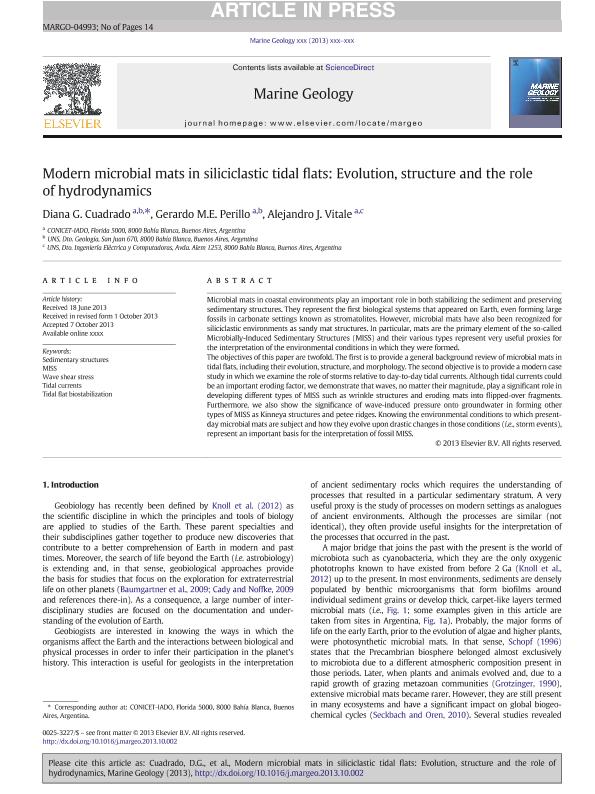Mostrar el registro sencillo del ítem
dc.contributor.author
Cuadrado, Diana Graciela

dc.contributor.author
Perillo, Gerardo Miguel E.

dc.contributor.author
Vitale, Alejandro José

dc.date.available
2017-01-16T18:38:55Z
dc.date.issued
2014-01
dc.identifier.citation
Cuadrado, Diana Graciela; Perillo, Gerardo Miguel E.; Vitale, Alejandro José; Modern microbial mats in siliciclastic tidal flats: Evolution, structure and the role of hydrodynamics; Elsevier Science; Marine Geology; 352; 1-2014; 367-380
dc.identifier.issn
0025-3227
dc.identifier.uri
http://hdl.handle.net/11336/11389
dc.description.abstract
Microbial mats in coastal environments play an important role in both stabilizing the sediment and preserving sedimentary structures. They represent the first biological systems that appeared on Earth, even forming large fossils in carbonate settings known as stromatolites. However, microbial mats have also been recognized for siliciclastic environments as sandy mat structures. In particular, mats are the primary element of the so-called Microbially-Induced Sedimentary Structures (MISS) and their various types represent very useful proxies for the interpretation of the environmental conditions in which they were formed. The objectives of this paper are twofold. The first is to provide a general background review of microbial mats in tidal flats, including their evolution, structure, and morphology. The second objective is to provide amodern case study inwhich we examine the role of storms relative to day-to-day tidal currents. Although tidal currents could be an important eroding factor, we demonstrate that waves, no matter their magnitude, play a significant role in developing different types of MISS such as wrinkle structures and eroding mats into flipped-over fragments. Furthermore, we also show the significance of wave-induced pressure onto groundwater in forming other types of MISS as Kinneya structures and petee ridges. Knowing the environmental conditions to which presentdaymicrobial mats are subject and howthey evolve upon drastic changes in those conditions (i.e., stormevents), represent an important basis for the interpretation of fossil MISS.
dc.format
application/pdf
dc.language.iso
eng
dc.publisher
Elsevier Science

dc.rights
info:eu-repo/semantics/openAccess
dc.rights.uri
https://creativecommons.org/licenses/by-nc-nd/2.5/ar/
dc.subject
Sedimentary Structures
dc.subject
Miss
dc.subject
Wave Shear Stress
dc.subject
Tidal Currents
dc.subject.classification
Geología

dc.subject.classification
Ciencias de la Tierra y relacionadas con el Medio Ambiente

dc.subject.classification
CIENCIAS NATURALES Y EXACTAS

dc.title
Modern microbial mats in siliciclastic tidal flats: Evolution, structure and the role of hydrodynamics
dc.type
info:eu-repo/semantics/article
dc.type
info:ar-repo/semantics/artículo
dc.type
info:eu-repo/semantics/publishedVersion
dc.date.updated
2016-12-01T19:39:30Z
dc.journal.volume
352
dc.journal.pagination
367-380
dc.journal.pais
Países Bajos

dc.journal.ciudad
Amsterdam
dc.description.fil
Fil: Cuadrado, Diana Graciela. Consejo Nacional de Investigaciones Científicas y Técnicas. Centro Científico Tecnológico Bahía Blanca. Instituto Argentino de Oceanografía (i); Argentina. Universidad Nacional del Sur; Argentina
dc.description.fil
Fil: Perillo, Gerardo Miguel E.. Consejo Nacional de Investigaciones Científicas y Técnicas. Centro Científico Tecnológico Bahía Blanca. Instituto Argentino de Oceanografía (i); Argentina. Universidad Nacional del Sur; Argentina
dc.description.fil
Fil: Vitale, Alejandro José. Consejo Nacional de Investigaciones Científicas y Técnicas. Centro Científico Tecnológico Bahía Blanca. Instituto Argentino de Oceanografía (i); Argentina. Universidad Nacional del Sur; Argentina
dc.journal.title
Marine Geology

dc.relation.alternativeid
info:eu-repo/semantics/altIdentifier/url/http://www.sciencedirect.com/science/article/pii/S0025322713002181
dc.relation.alternativeid
info:eu-repo/semantics/altIdentifier/doi/http://dx.doi.org/10.1016/j.margeo.2013.10.002
Archivos asociados
